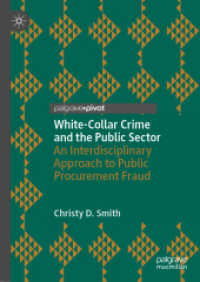- ホーム
- > 洋書
- > 英文書
- > Business / Economics
Full Description
Organizational Communication helps students understand their communication as participants in organizations throughout their lifetimes. It begins with how pre-career experiences influence our expectations for organizational experiences and ends with organizational exits, including retirement. This approach provides a seamless integration of theory and application while helping students at any stage of life reflect on past experiences, prepare for new endeavors and roles, and understand vital organizational theories and perspectives in new and concrete ways.
Contents
Preface
Acknowledgments
About the Authors
1. Introduction
Defining Communication
Information Transfer
Shared Meaning
Transactional Meaning Creation
Applying the Three Definitions of Communication
Working Definition
Defining Organizations
A Legal Definition of Organizations
A Social Definition of Organizations
A Communicative Definition of Organizations
The Complexity of Defining Communication in Organizations
Strategic Ambiguity
Ethical Issue: Strategic Ambiguity
Nonverbal Communication
Applying the Three Nonverbal Criteria
Communication Challenge: Office Design
Perspectives on Organizational Communication
A Post-Positivist Perspective
An Interpretive Perspective
A Critical Perspective
Other Perspectives
Application to Different Types of Organizations
Summary
Glossary
2. Communication and Anticipatory Socialization
Anticipatory Role Socialization
Family
Education
Communication Challenge: Realistic Expectations
Peers
Previous Experience
Communication Challenge: Comparing Workplaces
Media
Application
The







